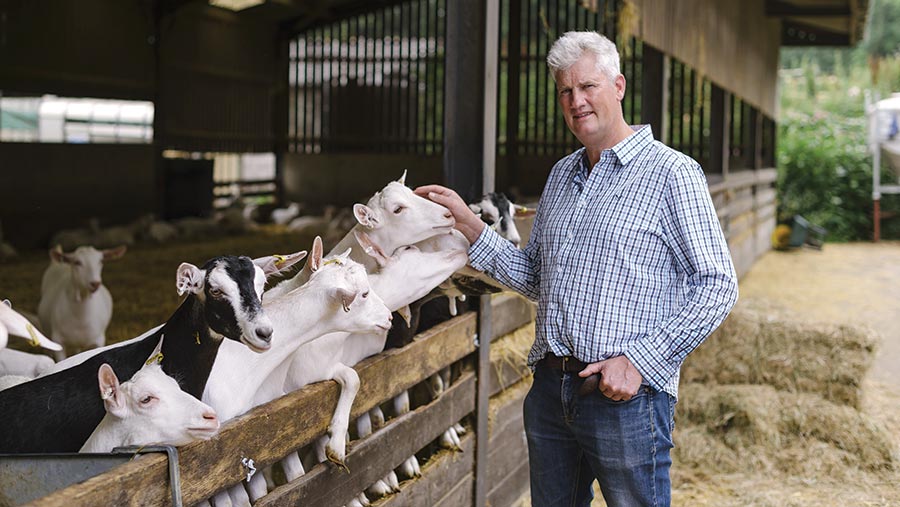Purpose-built shed helps goat farm cut weaning age
 Will Frost © Jim Wileman
Will Frost © Jim Wileman Investing in a purpose-built rearing shed and adjusting kid management protocols have helped goat milk producer Will Frost to reduce age at weaning by up to two weeks.
The 2019 Farmers Weekly Dairy Farmer of the Year, who shares kidding responsibilities with his wife, Katie, explains the strategies that enable six-week weaning at Forde Grange Farm in Thorncombe, on the Dorset-Somerset border.
See also: Roofless dairy buildings: Savings, benefits and pitfalls
1. Strict hygiene at kidding
Nannies kid in a dedicated kidding shed, in individual pens, each with a supply of clean, warm water. Providing warm water encourages higher intakes and this has obvious benefits since water consumption is linked to milk production and overall health.
Dry disinfectant is applied to fresh straw bedding between kiddings and pens are cleaned out. Using a dry product creates a dry, sterile environment. It keeps everything nice and dry and kills staph aureus, the biggest cause of mortality in goats.
2. Kids get high-quality colostrum and plenty of it
Within two hours of birth, kids receive 300ml of their mother’s colostrum. To guarantee intakes, colostrum is fed via a stomach tube. Navels are sprayed with iodine. Each kid is tagged and matched with its dam, and remains with her for 24 hours.
3. 48-hour housing in converted IBCs
Cryptosporidium infection had been the biggest cause of kid mortality in the first few days of life, but converted intermediate bulk containers (IBCs) offer a protective environment.
Each one of the 14 IBCs accommodates eight kids, each on a bed of wood shavings under a single heat lamp.
Occupancy of the IBCs is rotated so that all kids have a clean disinfected environment.
The beauty of IBCs is that they can easily be washed out and disinfected between batches. This really does help with coccidiosis and cryptosporidium control, says Mr Frost.
This housing system also allows the kids to get individual attention for 48 hours, to ensure they are drinking properly. After colostrum, kids are reared on a ewe milk replacer.
This is mixed in an automatic machine, poured it into a milk bar which is then wheeled to the IBC and the kids drink from this.The milk bar is more efficient than using bottles.
Providing they are drinking well, they are then transferred to a specialist kid shed.
4. Controlled housing temperature and ventilation
Kid mortalities have halved from 12% to 5% since Mr Frost built a new temperature-controlled rearing shed three years ago at his second site, Childhay Farm.
“We had seen a similar facility during a visit to France,” he says. “We liked the principle of all-in all-out. The shed we visited was well insulated and had automatic ventilation. That makes all the difference.”
They liked the shed so much they mirrored its features in their new shed, which has been built to house 450 kids up to weaning. The shed is divided into 16 straw-bedded pens with one heat lamp for every 25 kids.
A wide central passageway between the pens allows easy access for bedding and feeding. Beds are freshened daily with straw.
Milk powder is fed through two automatic Euro feeders – one for every 250 kids, with a total of three feed stations per pen.
Kids are fed ad-lib haylage and lamb creep feed from one week old.
The key to getting the shed to perform to the optimum is to fill it as quickly as possible, to take advantage of the heat generated by the animals.
This reduces heat lamp use and the associated electricity costs.
“The lamps are on for the first 10 days but if we have sufficient kids in the shed we can turn them off,” he says.
Herd facts
- Closed herd of 2,500 mainly British Saanen goats
- Females kidded in four five-week blocks
- 80-point rotary parlour
- Twice-a-day milking – a three-times-a-day milking system had operated until September 2019
- Annual milk yield per goat 1,250 litres
- Milk supplied to Delamere Dairies
- Replacement rate of 35% due to selective culling
- Replacements bred from top 20% of females
The shed is fitted with ceiling fans and automatic ventilation curtains. The controlled environment maintains the air temperature at 14-18C, meaning the kids’ respiratory systems are not challenged when nights are cold and days very warm.
If the outside temperature is below 14C the curtains are closed and the fans are switched off, but there is a refresher cycle which gives a 30-second vent every 10 minutes in those conditions.
As the building is insulated there is no condensation to dampen the straw bedding.
5. All kids are vaccinated
Kids are vaccinated with Heptavac P at two weeks and at five weeks because the stress associated with weaning can cause clostridial diseases.
Coccidiosis can also flare up at weaning so they are given Vecoxan prior to weaning, which works well.
6. Weaning is based on kid weight
Weight is the main criteria for weaning.
“We regularly weigh kids to optimise weaning time and aim to wean at a minimum of 15kg,” Mr Frost says.
Kids also need to be eating 150g of hard feed and plenty of fibre in the form of hay or barley straw.
“We have tried both gradual weaning and abrupt weaning and have favoured abrupt weaning as a more suitable system.
“If all goes well a batch of kids will be weaned at six weeks old at 15-17kg.”
About Farmers Weekly Awards 2020
 The Farmers Weekly 2020 Dairy Farmer of the Year Award is sponsored by ……..
The Farmers Weekly 2020 Dairy Farmer of the Year Award is sponsored by ……..
Join Farmers Weekly in celebrating the farming industry and recognising the hard work of UK farmers and enter the awards today.
Alternatively, nominate a deserving individual for an award.
For more information about the Farmers Weekly Awards 2020, pay a visit to the official website.
